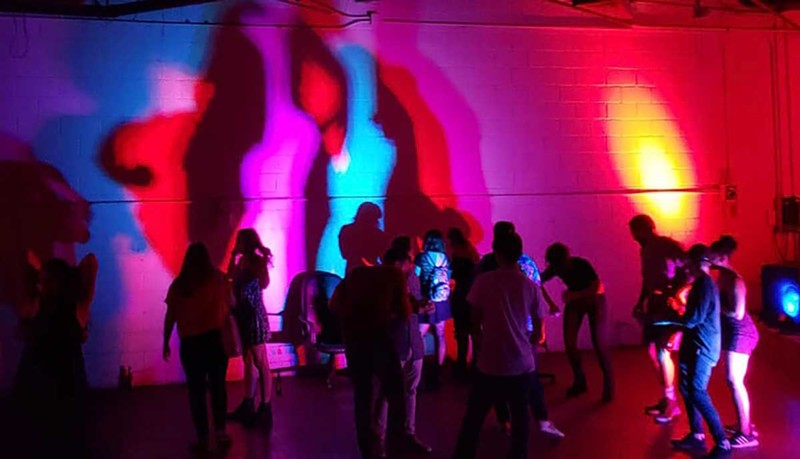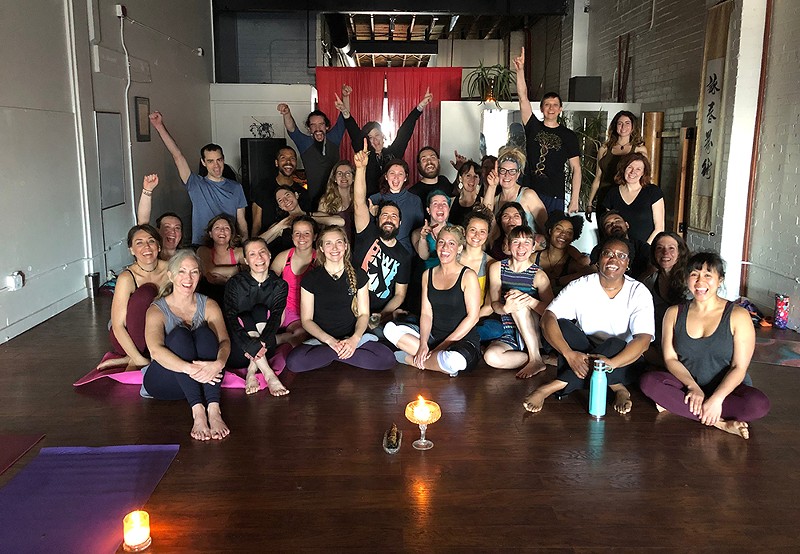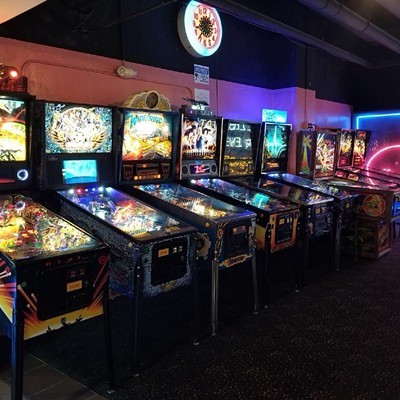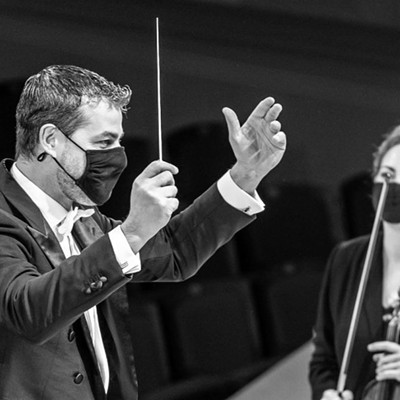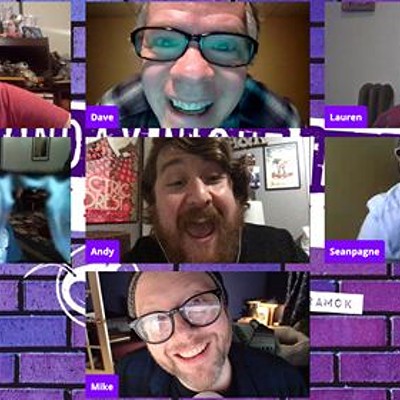I leap across the floor, launching off one foot and landing on the other as I roll myself into a ball, withdrawing inward. I haven’t done ballet since I was a child, and this feels like a stage of a different name where I’m playing my inner child instead of a written character.
Moving without inhibition, I laugh and howl as my laughter turns to tears and then smiles so big my face hurts. I have never experienced joy like this in my life.
That’s how ecstatic dance is supposed to feel.
In Detroit, several groups organize “ecstatic dances” and other conscious meetups like Dance Meditation Technique that can foster feelings of ecstasy without the help of any drugs.
“Ecstatic dance, on the surface level, is conscious clubbing… meaning it’s a safe space from judgment and people are mindful of themselves,” says Charity Loring, the Founder of Detroit and Ann Arbor Ecstatic Dance. “But on a deeper level, it can be [about] being true to yourself in each moment to work through any emotions you might have, any physical stress, pain, or anything else. It’s really just a safe container to be self-expressive in each moment.”
Loring hosts two dances a month, one in Detroit and another in Ann Arbor. She stresses they are strictly sober spaces and yes, that includes marijuana.
Bass-heavy EDM music bounces off the walls, riding a wave into heavy dubstep before slowing back to soothing instrumental amid flashing strobe lights. Participants dance mostly by themselves, getting lost in their own universe, rolling around on the floor, whipping their hair around, and tying bells to their ankles to make their own soundtrack. They can dance with each other by asking for permission nonverbally.
Before any dancing starts, Loring gathers all the participants in a circle where she lays out the rules: do whatever feels good, slither like a snake, or howl at the moon you feel like it. If you want to dance with someone, approach them with an open-armed gesture. To accept, return the gesture or bow politely to decline. No talking is allowed but singing and noise-making is more than welcome.
In an opening circle, Loring invites everyone to share how they’re feeling or what they hope to get out of the experience. Some are here just to dance freely without feeling judged like they may at a bar or club. Others are hoping for a cathartic release from the stress, anger, and frustration they’re carrying. I’m just here to endure the full human experience with grace.
Loring, who is also a licensed therapist, has been holding ecstatic dances in metro Detroit for about four years. The first time she experienced ecstatic dance was at a weekend campout in Portland where clothing was optional.
“It blew my mind because I had never experienced that before,” she says, bursting into laughter at the thought of dancing naked. She tells me that she and most people in attendance stayed clothed. “But it was so good to feel safe in my own body to express and explore anything I needed to and know that my process was not going to get interrupted by somebody trying to grope me, or anything like that. Unless, of course, if I’m into that kind of thing, and then I can give permission, because I’m all about freedom of sexuality, too.”
At the time Loring had taken what she calls a “two-year relationship sabbatical” to focus on her mental and emotional health. During that first dance, she says, emotions that were stuck in her body surfaced, despite all the work she had done in addressing her psychological well-being.
“As I was dancing, I remember there was this moment where I was thanking myself for the time I took to truly understand and love myself, and my body was like ‘What about me?’” she remembers. “As I was thinking that, I made this big stretch and just let my body move to the music and let that be my intoxicant... It almost felt like my ribcage was cracking open, but it was just the muscle tension finally releasing in a way that it hadn’t before. And then I experimented with other movements in my body where I was feeling pain, and I realized I can create just as much safety and comfort in these parts of my body as I did my brain for those two years.”
She was so moved by the experience that she tried desperately to find something comparable in Detroit, but couldn’t. Sure, she could just go to the club, but nightclubs aren’t exactly enjoyable for sober people who are looking for something more meaningful than partying and showing up just to be seen.
“My only other option to move in a dance style was to either take a class, which is very formal, or go to the club. But then if people are drunk they usually get handsy or [are] spilling beer on people or whatever,” she says. “When I experienced these ecstatic dances, it was a full body-mind experience for me and I kept wishing we had it here. Like why isn’t there ecstatic dance in Detroit? We’re the home of Motown and techno. We are musically based people. So one morning I woke up and I was like, I need to stop wishing and start doing.”
“When I experienced these ecstatic dances, it was a full body-mind experience for me and I kept wishing we had it here. Like why isn’t there ecstatic dance in Detroit? We’re the home of Motown and techno.”
tweet this
That was the beginning of Loring’s ecstatic dance meetup. Besides her own experience, she also noticed how therapy clients’ body language would betray their words and the lies they tell themselves about others about their mental health.
“I could see somebody say, ‘I’m fine, I’m fine’ and their shoulders are up here and they’re so tight,” she says clenching her shoulders up towards her ears. “Even though their brain may fully have believed that, their body wasn’t connecting with that. I could see that in others and I could also notice it in myself. Like, ‘My life is great! Everything’s going great!’ but I would feel a tension in my chest, in my shoulders, and my stomach a lot of the time and I couldn’t figure out why.”
While clothing is not optional at Detroit and Ann Arbor Ecstatic Dance, dancing is.
During one of Loring’s rare ecstatic dance day retreats, I decided to take a nap instead. It was the second dance of the day and I was physically and mentally exhausted from the first two hours of flailing around and crying.
Loring stresses that you don’t actually have to know how to dance to attend either.
“I’ve heard so many times ‘I can’t come to those dances because I’m not a good dancer,’ but I’m like, you don’t have to be. You can come around and flop on the floor like a fish the whole time if you want to, or sit and meditate and observe or whatever,” she says. “But this movement process can be so liberating because the stress response that affects our brain and our body is trying to do its job. It’s trying to release tension and give us the rest we need but sometimes everyday life can be traumatizing so that stress response is always on high.”
She continues, “Sometimes we don’t even realize that our stress response in our body has been at a nine out of 10 for days, weeks, maybe months, or maybe a whole lifetime. When you go into a practice where you can literally move however the heck you want to, people start to realize, ‘I had no idea I’ve been sitting like this for the last three days.’”
Are “judgment free zones” real?
At the Detroit Kung Fu Academy, dancers gather in a dim, candlelit room for Dance Meditation Technique or “DMT.” Similarly to ecstatic dance, DMT is a free movement practice, but its founder and creator Michael Patrick Peters considers it more of a “concentrated meditation effort” rather than a social meetup.
“You ever realize how much money people spend to go to the best dance clubs in the world, but then you get there and nobody’s dancing?” he tells the room of mostly women who’ve gathered for DMT.
It’s the exact opposite of what happens here.
As participants being to warm up with some gentle movement Peters explains the “soundwheel,” a call-and-response practice where when one person yells or screams, everyone is encouraged to do it back.
As everyone eventually breaks out into their own movement, skipping, stomping, and floating around the room in a circle, Peters occasionally riles everyone up by running through the crowd and yelling over the electronic music. The group responds in a roar.
By the end, I’m haggard with a strained voice but somehow feeling much more at ease than when we began.
Peters instructs participants to keep a “soft gaze” so the practice is more introspective. There is an awareness of the other people in the room, so as not to crash into them while moving about, but it’s an inward journey.
“People who have been in my classes dozens of times, or hundreds or more, they develop a sense of feeling more connected to themselves and the room,” he says. “So even though they’re not dancing with anyone or staring, they still feel even more connected than if they were… it’s also incredible cardio. You know, I hate running [and] jogging but I can do a 10k in class and it’s like, I’m smiling the whole time.”
He uses taglines for DMT like “best whole being workout of your life or your money back.” After two hours of nonstop dancing and screaming, I understand why.
“You ever realize how much money people spend to go to the best dance clubs in the world, but then you get there and nobody’s dancing?”
tweet this
“People come to class and they love it. They try to explain it to other people and it’s impossible to explain,” he says. “So when you’re asking, what’s the elevator pitch, I don’t know it... [We say] ‘Lose 100 pounds of emotional weight’ or ‘Learn how to transform the emotional weight and the mind power.’ These things are all applicable. Does it explain what we do? No, not really.”
DMT classes have been primarily advertised through social media and word of mouth since Peters began offering them in 2011. There are no photos or videos allowed during the gathering.
Peters developed the technique through a seemingly lifelong search for meaning that led him to study Zen and Tibetan Buddhism, Qi Gong, Sivananda Yoga, and other spiritual paths. It began with his grandmother’s death when he was 18 years old, which forced him to come to terms with the reality of impermanence.
“DMT was born out of immense pain and suffering and my effort to… find out what is this thing that they’re calling ‘life?’” he says. “Everybody’s terrified. They might be hiding it from themselves, but they know it. They know that at any moment, everything can go… But until someone realizes things are impermanent, it’s difficult to take our spiritual practice with urgency and seriousness.”
In seeming opposition to ecstatic dance, Peters rejects the idea of “judgment-free zones” as, according to him, human beings are always processing information and using discernment to judge situations. They are, however, both sober spaces.
“Words are very important to me and I see the effect in class,” he says. “If I were to walk into my class and say, ‘This is a judgment-free space,’ I just condemned everyone who’s judging. And guess what? Everybody is judging. The only judgment-free space is where there are no human beings.”
He also expresses his distaste for phrases in the wellness space like “positive vibes only” and “just let it go” as it disregards the reality of human emotions.
“If you just tell someone to let go, it’s not going to happen,” he says. “Take a young couple [for example], and they have a family, and one of them had an affair that was heartbreaking. Then you have spiritual elders telling the other person to just let go. There’s no switch that you can hit where it ‘let’s go.’ But what does work? Validating someone’s humanity. Yeah, your feelings are hurt. That makes sense.”
Peters puts this into practice before the dancing begins by telling students “Yeah, you’re scared to be in my class. It’s unusual if you’ve never done it. You’re an intelligent human. That’s what that means.”
Not only does DMT (the movement practice, not the psychedelic) provide an alternative to clubbing and drinking, it’s a moving meditation that Peters says allows people to escape their thoughts if only for a moment.
“This practice, the intensity of the movement, the intensity of the voice, produces the conditions for the mind to just naturally stop. When that happens, that’s the thing that people talk about, letting go,” he says. “Here’s the thing, it’s not permanently gone, but it’s gone for just a moment and that moment is a big deal. For those of us who have suffered from severe anxiety and depression, to get five minutes of relief is invaluable.”
Dance Meditation Technique is held the first Sunday of every month at Detroit Kung Fu Academy; 3364 Michigan Ave., Detroit; dancemt.com. More information is available on Instagram at @dancemeditationtechnique.
Loring hosts an ecstatic dance on the second Friday of the month at Ringstar Studio; 3907 Varsity Dr., Ann Arbor; a2ringstar.com; and the fourth Friday of every month at Andy Arts Center; 3000 Fenkell Ave., Detroit; andyarts.org. More information is available on Instagram at @detroit_a2_ecstatic_dance.
Subscribe to Metro Times newsletters.
Follow us: Google News | NewsBreak | Reddit | Instagram | Facebook | Twitter

